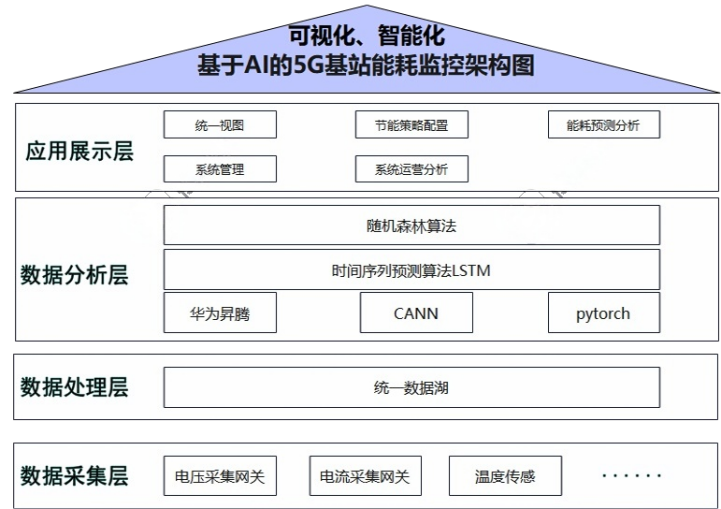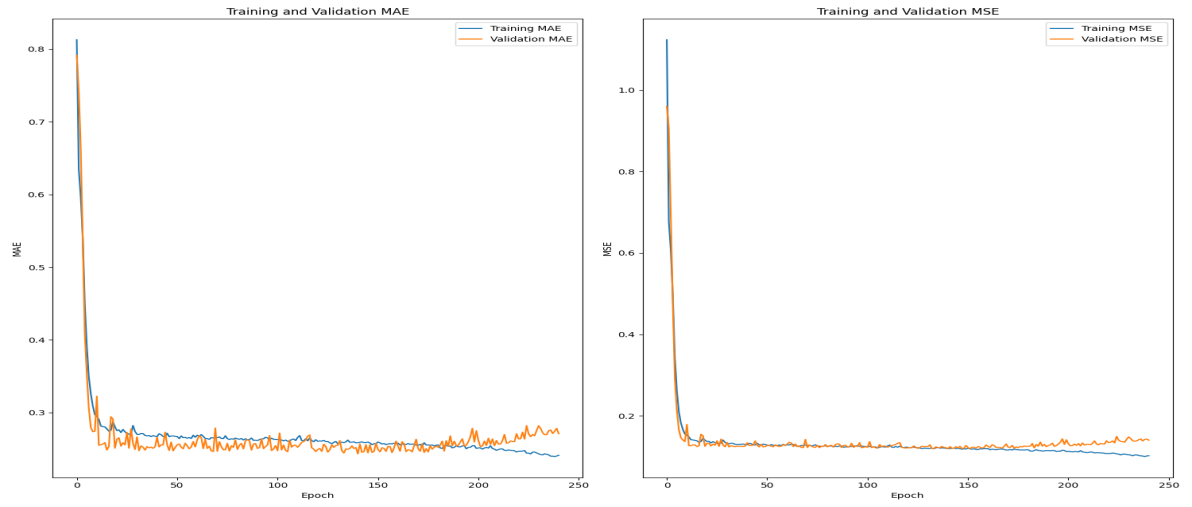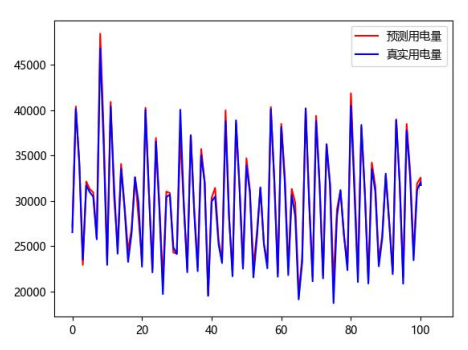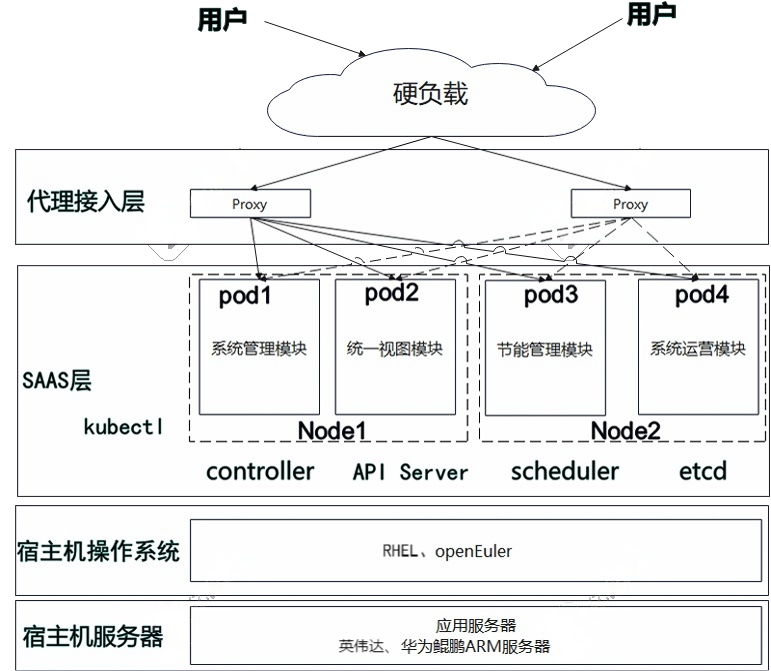1. Introduction
Energy consumption by base station equipment accounts for up to 50% of the total energy usage in wireless networks [1]. With the rapid deployment and application of 5G networks, and given the characteristics of high-frequency bands and large-scale antenna arrays, the energy consumption of 5G base stations has imposed significant operational cost pressures and environmental burdens on operators. Therefore, effectively supervising and optimizing 5G base station energy consumption has become an urgent issue. Traditional energy management methods rely on a “one-size-fits-all” timed energy-saving approach. As user experience expectations rise, such methods no longer meet the complex demands of 5G network scenarios. The development of the Internet of Things (IoT), cloud computing, and artificial intelligence technologies provides new solutions for supervising 5G base station energy consumption. This study aims to design an AI-based cloud platform for 5G base station energy consumption supervision. By employing intelligent methods, the platform seeks to improve the efficiency of energy management, reduce base station energy consumption, lower operators’ operational costs, promote the green and sustainable development of 5G networks, support national strategic goals, and facilitate sustainable socio-economic development.
2. Analysis of the current status of 5G base station energy consumption supervision
The energy consumption characteristics of 5G base stations are mainly reflected in the following aspects: First, the introduction of Massive MIMO (Multiple Input Multiple Output) large-scale antenna technology in 5G wireless networks [2] significantly increases base station power consumption. Second, the support for diverse service scenarios in 5G networks leads to substantial fluctuations in base station energy use. Third, the high deployment density of 5G base stations results in a large overall energy consumption scale. These characteristics pose significant challenges to the management of 5G base station energy consumption. The main issues in energy management include: First, lack of real-time and accurate energy monitoring methods; Second, difficulty in accurately predicting changes in base station energy consumption; Third, inability to achieve intelligent energy optimization control. Therefore, it is imperative to build a comprehensive energy supervision platform capable of real-time monitoring, intelligent analysis, and optimized control.
3. Capability framework of the AI-based 5G base station energy supervision cloud platform
The construction of an AI-based 5G base station energy supervision platform is a highly complex project, encompassing an end-to-end process from data collection, data processing, AI analysis and prediction, to visualization and energy-saving strategy formulation. The platform is built on a domestically produced computing infrastructure, iteratively optimizing algorithms based on collected data to establish a comprehensive supervision system.
The energy supervision platform adopts a four-layer technical architecture, including the data collection layer, data processing layer, data analysis layer, and application layer. The data collection layer gathers operational data such as voltage, current, and server temperature from base stations via IoT gateway terminals. The data processing layer aggregates multi-source data to construct a data lake foundation. The data analysis layer, based on Huawei Ascend AI computing platform, employs deep learning algorithms such as LSTM for energy consumption prediction and anomaly detection, and integrates reinforcement learning to generate energy-saving strategies. The application layer provides functionalities including energy consumption visualization, strategy configuration, and system management. The overall technical architecture and the functions of each layer are shown in Figure 1.

4. Research on key platform technologies
The platform’s main functional modules include the data collection module, energy prediction and optimization control module, and visualization module. These modules work collaboratively to achieve comprehensive supervision and optimization of 5G base station energy consumption, thereby realizing energy saving and emission reduction.
4.1. Research on IoT data collection technology
Energy consumption data from base stations are collected in real time via edge gateways and sensors, supporting protocols such as MQTT and HTTP to ensure efficient and stable upload to the cloud platform. By deploying sensors and monitoring devices, real-time energy data of communication base stations—including electricity consumption, equipment power usage, and cooling system energy consumption—can be captured. This data provides an intuitive understanding of base station energy usage and forms the foundation for subsequent energy optimization [3].
4.2. Research on AI-based prediction technology
Long Short-Term Memory (LSTM) networks are a type of recurrent neural network (RNN) designed to handle long-term dependencies in time series data through recurrent memory units [4]. They address the gradient vanishing and exploding problems encountered by traditional RNNs when processing long sequences. By incorporating gating mechanisms, LSTM networks can effectively capture long-term dependencies, and have been widely applied in fields such as natural language processing, speech recognition, and time series forecasting.
In this platform, an LSTM neural network is employed for time series prediction, where the gating mechanism effectively captures long-term dependencies. The network structure consists of three stacked LSTM layers to enhance feature extraction capabilities.

For model training, electricity consumption data from a certain city, recorded for every hour from January 1, 2016, to January 1, 2018, totaling 17,520 time series data points, were used as the dataset. This dataset spans a long period and contains a large volume of data, providing substantial real-world value.

In the LSTM model, the training and testing data are represented as XXX and YYY, where XXX consists of the first 23 data points and YYY is the 24th data point. The experimental data are hourly time series, and a sliding window of 24 hours (representing one full day’s electricity consumption) is used. During training, the first 23 data points in the window serve as input to predict the 24th data point. By comparing the predicted value with the actual 24th data point, the prediction error (loss) is calculated, allowing the model parameters to be continuously optimized.
(4) Experimental Results and Analysis
The dataset was split into training and testing sets in an 8:2 ratio. After training for 300 epochs, the model converged. Since the LSTM task is a regression problem, both the Mean Squared Error (MSE) and Mean Absolute Error (MAE) indicators show satisfactory performance.

For testing, a 100-hour period from 00:00 on October 1, 2017, to 04:00 on October 5, 2017, was selected. On October 1, electricity consumption was relatively high, peaking around 12:00 due to holiday-related factors such as intensive commercial activity, tourism, and family gatherings, which significantly increased energy demand. As shown in Figure 5, the predicted electricity consumption closely matches the actual values, with minimal prediction error.

Based on the prediction results, the platform dynamically adjusts the base station transmission power using a deep Q-learning algorithm. During periods of low electricity demand (troughs), the system reduces transmission power; during periods of high demand (peaks), it increases transmission power.
4.3. Research on modular technology of the application display layer
To achieve microservice-based deployment, the display layer adopts a cloud-native architecture combining Vue, Spring Cloud, and Kubernetes. The front end is built with Vue.js to construct a component-based user interface. The back end is based on the Spring Cloud microservice framework, decoupling each functional module so that each microservice is responsible for a specific business function. Service deployment leverages Kubernetes to enable containerized deployment, facilitating rapid deployment, high availability, and elastic scaling. The detailed system architecture is illustrated in Figure 6.

5. Research conclusions
This study designed an AI-based cloud platform for 5G base station energy supervision, effectively addressing key challenges in managing 5G base station energy consumption. During platform implementation, deep learning frameworks and Kubernetes container orchestration technologies were employed. The energy prediction model is based on the LSTM neural network, trained using historical energy consumption data, while the energy optimization algorithm utilizes deep Q-learning to intelligently adjust base station parameters. The platform is deployed in an OpenStack cloud environment, ensuring system scalability and reliability.
Through actual deployment and testing, the platform demonstrated excellent performance. The energy consumption prediction accuracy exceeded 92%, and the F1-score for anomaly detection reached 0.89. Regarding energy optimization, the platform reduced base station energy consumption by 15%-20%, significantly improving energy utilization efficiency. Compared with traditional energy management methods, this platform shows substantial improvements in prediction accuracy, optimization effectiveness, and response speed.
6. Summary and outlook
This study developed an AI-based cloud platform for 5G base station energy supervision, effectively addressing key issues in 5G base station energy management. By leveraging deep learning and reinforcement learning techniques, the platform achieves precise energy consumption prediction and intelligent optimization, supporting the construction of green and efficient 5G communication networks and promoting the sustainable development of a digital society [5]. Future research will focus on further enhancing the platform’s intelligence, exploring additional energy-saving strategies, and laying the groundwork for energy management in 6G networks.
Funding
Shandong Vocational College of Engineering 2024 Internal Research Fund Project: Research on an AI-Based 5G Base Station Energy Supervision Cloud Platform (Project No.: SGZK012; Principal Investigator: Xuejie Ma)
Shandong Vocational College of Engineering 2023 Internal Research Fund Project: Research on Indoor Intelligent Logistics Robot Path Planning Technology (Project No.: SDGCZK2326; Principal Investigator: Hui Gong)
References
[1]. China Mobile. (2020, September 3). 5G base station energy-saving technology white paper [White paper]. Retrieved December 21, 2022, from https: //www.xdyanbao.com/doc/tnwqgv16jh?bd_vid=10629406145017760696
[2]. China Telecom. (2018, June 26). 5G technology white paper [White paper]. Retrieved December 21, 2022, from http: //www.chinatelecom.com.cn/2018/ct5g/201806/P020180626325489312555.pdf
[3]. Qi, X. Y. (2023). Exploration of energy-saving methods for 5G base stations. Jiangsu Communications, 39(02), 24–28.
[4]. Gao, Z. Y., Xing, J. C., Zhang, X. W., et al. (2024). Study on building energy consumption prediction based on attention mechanism CNN-LSTM. HVAC, 54(8), 48–55.
[5]. Zheng, W. B., Zong, L. S., & Zhu, P. F. (2023). Energy-saving and intelligent exploration of power supply technology for 5G communication base stations. Yangtze Information and Communication, 36(12), 221–223.
Cite this article
Ma,X.;Gong,H.;Wang,X. (2025). Research on an AI-Based Cloud Platform for 5G Base Station Energy Consumption Supervision. Applied and Computational Engineering,197,9-14.
Data availability
The datasets used and/or analyzed during the current study will be available from the authors upon reasonable request.
Disclaimer/Publisher's Note
The statements, opinions and data contained in all publications are solely those of the individual author(s) and contributor(s) and not of EWA Publishing and/or the editor(s). EWA Publishing and/or the editor(s) disclaim responsibility for any injury to people or property resulting from any ideas, methods, instructions or products referred to in the content.
About volume
Volume title: Proceedings of the 7th International Conference on Computing and Data Science
© 2024 by the author(s). Licensee EWA Publishing, Oxford, UK. This article is an open access article distributed under the terms and
conditions of the Creative Commons Attribution (CC BY) license. Authors who
publish this series agree to the following terms:
1. Authors retain copyright and grant the series right of first publication with the work simultaneously licensed under a Creative Commons
Attribution License that allows others to share the work with an acknowledgment of the work's authorship and initial publication in this
series.
2. Authors are able to enter into separate, additional contractual arrangements for the non-exclusive distribution of the series's published
version of the work (e.g., post it to an institutional repository or publish it in a book), with an acknowledgment of its initial
publication in this series.
3. Authors are permitted and encouraged to post their work online (e.g., in institutional repositories or on their website) prior to and
during the submission process, as it can lead to productive exchanges, as well as earlier and greater citation of published work (See
Open access policy for details).
References
[1]. China Mobile. (2020, September 3). 5G base station energy-saving technology white paper [White paper]. Retrieved December 21, 2022, from https: //www.xdyanbao.com/doc/tnwqgv16jh?bd_vid=10629406145017760696
[2]. China Telecom. (2018, June 26). 5G technology white paper [White paper]. Retrieved December 21, 2022, from http: //www.chinatelecom.com.cn/2018/ct5g/201806/P020180626325489312555.pdf
[3]. Qi, X. Y. (2023). Exploration of energy-saving methods for 5G base stations. Jiangsu Communications, 39(02), 24–28.
[4]. Gao, Z. Y., Xing, J. C., Zhang, X. W., et al. (2024). Study on building energy consumption prediction based on attention mechanism CNN-LSTM. HVAC, 54(8), 48–55.
[5]. Zheng, W. B., Zong, L. S., & Zhu, P. F. (2023). Energy-saving and intelligent exploration of power supply technology for 5G communication base stations. Yangtze Information and Communication, 36(12), 221–223.









